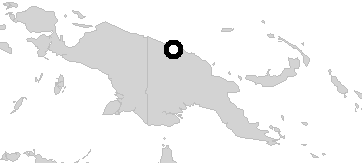
| www.CuriousTaxonomy.net |
|
The Flood in World Myth and Folklore
New Guinea |
| © 2021 Mark Isaak |

Some musicians in Bibriweh Village, in the area of Wareli, sang and danced until dawn. Then they went down to the river to bathe. While they were bathing, a heavy rain came, and they ran and took shelter in a big casuarina tree. There they fell sound asleep. The rain, however, continued falling, and the river flooded, carrying the tree downstream to the village of Lehinga. The people there found the people in the tree and put them in a new village called Malahun, which grew into the village it is today.
Slone, 2001, 2: 954-955.

An alternate ending to this myth includes no flood but tells the origin of different languages. The sons, climbing down from a palm where they picked fruit, were each in turn bitten by insects at the base of the tree, whereupon each spoke a different language. The youngest son came to speak English.
In the beginning, one man lived all alone. One day he heard voices coming from the river and went to investigage. He saw cassowaries come, take off their skins to become women, and bathe in the river. While they were bathing, he stealthily went to the pile of skins and took the skin of the leader, Nambweapa'w, whom he thought the most beautiful. He hid the skin in a short bamboo tube and waited.
When the women returned to put on their skins, Nambweapa'w could not find hers, and at length the other cassowaries left her to look on her own. Then the man approached and invited her to his home for food and shelter. They became husband and wife and, over the years, had many children, alternating boys and girls, with the youngest child a boy. One day, the youngest son wanted his mother to give him more coconut to eat, and when she would not, he said, "If you give me more, I will tell you a secret about your husband." (He had earlier seen the husband take the cassowary skin from its bamboo tube and hide it again.) Nambweapa'w gave him the coconut and learned the secret. She put on the skin and ran off. Before she left, though, she told her childen, "When the nuts on these tulip trees are ripe, come looking for me."
When the time came, the children went looking for Nambweapa'w and soon found her. She led them to a forest which, while they slept, became a large village. They live there in ease because the mother's magic did almost all of the work of planting and harvesting the garden. Each young man took the next younger daughter as a wife, all except the youngest boy, who had no younger daughter. The mother, however, forbade them from eating one certain type of yam.
After many years, though, the sons and daughters, except for the youngest, gave into curiosity and ate some of the yams. To punish them, Nambweapa'w told the youngest son to hunt for a tree kangaroo at a certain location. Then she turned herself into a tree kangaroo so that the boy speared her. She resumed her form, told her son that from now on people will suffer and die, and then died.
The son, grieving his mother and furious with his siblings, went to scold them for breaking the taboo. His fury was so great that a flood swirled up around him and carried him and the log he was standing on to America. The coming of the white man is the return of our little brother, come to show us what had been lost.
Donald F. Tuzin, The Voice of the Tambaran (Berkeley: University of California Press, 1980), 1-8.
